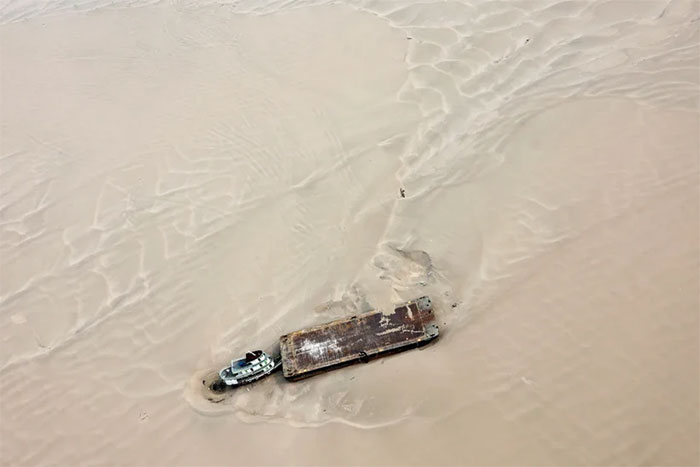Main Amazon River Tributary Falls to All-Time Low
Environmentalists say climate change and global warming are not only drying up rivers in the Amazon but also causing unprecedented wildfires, destroying the parched vegetation.

A water barge ran aground on a sandbar in the Solimoes River. (Source: Reuters).
On September 30, the water level of the Solimoes River , one of the two largest tributaries of the Amazon River in Brazil, dropped to an all-time low, disrupting the lives of residents in coastal villages. This is the result of the most severe drought on record in the Amazon region.
According to the Brazilian Civil Defense Agency, in Manacapuru, about 100km upstream from the capital of Manaus in the state of Amazonas, where the Solimoes River joins the Rio Negro to form the majestic Amazon River, the depth of the Solimoes River is only about 3m, 11cm lower than the record low recorded on October 25 last year.
As it is still the dry season, experts predict that the water level of the Solimoes River, which flows down from the Andes in Peru, will continue to fall in the coming weeks, exacerbating the crisis for communities living along the river.
The villages are now isolated because there is no means of transport across the shallow water. Instead of travelling by boat, villagers have to walk for 2 hours across the open riverbed to get home.
In particular, residents here are lacking both food and water, as fish resources are depleted and domestic water sources are also decreasing.
Environmentalists say climate change and global warming are not only drying up rivers in the Amazon but also causing unprecedented wildfires, destroying the parched vegetation.
- 'Red river' in China: The rain changes brilliant colors, the drink made from this river water is famous for everyone
- Found the cause of the Amazon River instead of flow
- Pollution changes the color of rivers in China
- Why does the Amazon River longer than 6,000km without a bridge spanning?
- Thailand studies a flow of a tributary of the Mekong
- The Amazon River emits most of the carbon absorbed by the Amazon
- The Amazon river system originated in Peru
- Amazon underground river is not ... river
- The river has two colors of water mixed in Brazil
- The new discovery helps the Amazon River become the world's longest river
- The river boiled water boiled everything in the Amazon forest
- Amazon River 11 million years old
 Is the magnetic North Pole shift dangerous to humanity?
Is the magnetic North Pole shift dangerous to humanity? Washington legalizes the recycling of human bodies into fertilizer
Washington legalizes the recycling of human bodies into fertilizer Lightning stone - the mysterious guest
Lightning stone - the mysterious guest Stunned by the mysterious sunset, strange appearance
Stunned by the mysterious sunset, strange appearance